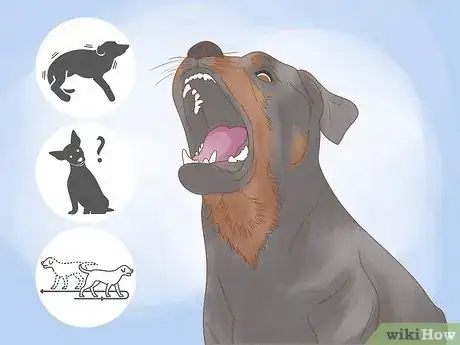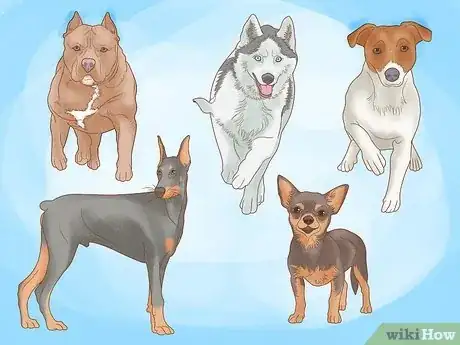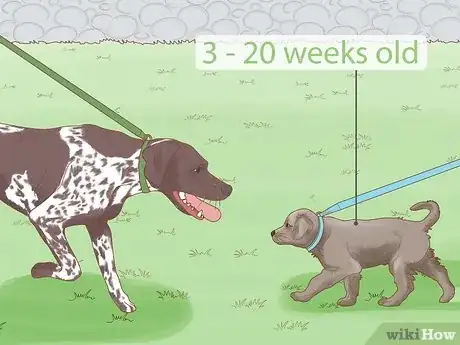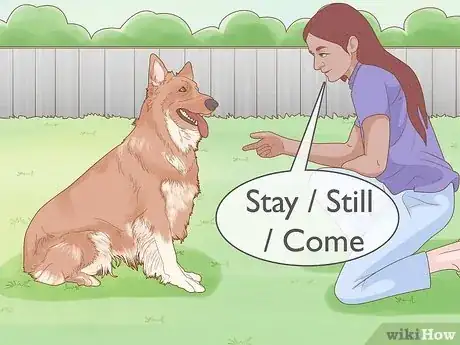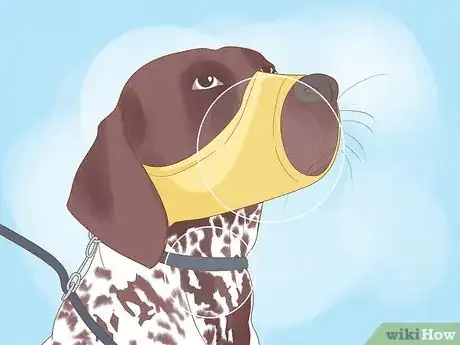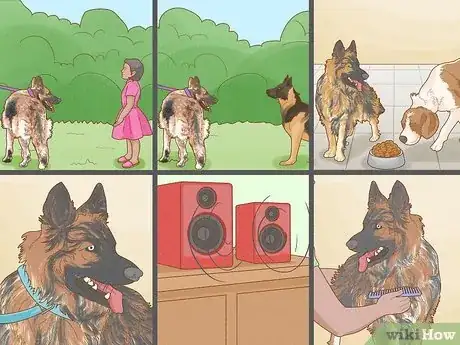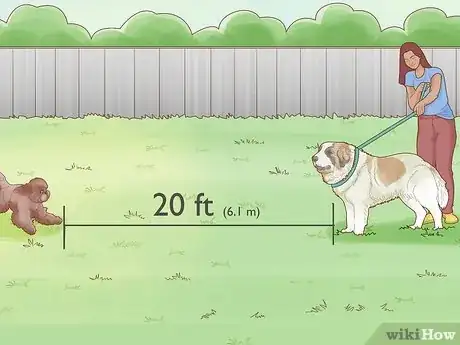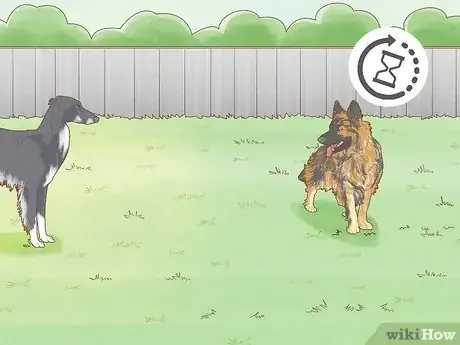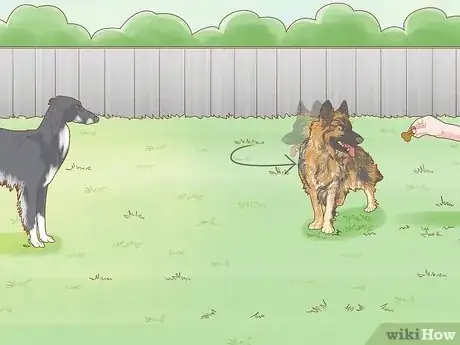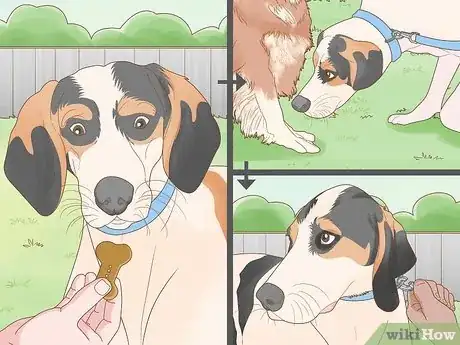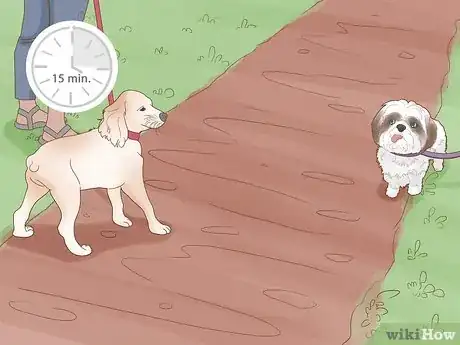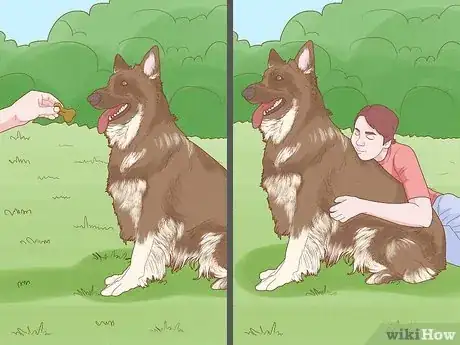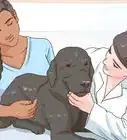This article was co-authored by Rendy Schuchat and by wikiHow staff writer, Amber Crain. Rendy Schuchat is a Certified Professional Dog Trainer and the Owner of the largest dog training facility, Anything Is Pawzible, based in Chicago, Illinois. With over 20 years of experience, Rendy specializes in positive dog training and behavior modification to help people build and strengthen their relationships with their dogs. She holds a BA in Psychology and Communications from the University of Iowa, an MA in Psychology from Roosevelt University, and a Certification in Dog Obedience Instruction from Animal Behavior Training and Associates. Rendy was voted one of the Best/Favorite Dog Trainers in Chicago by Chicagoland Tails Reader’s Choice Awards multiple times and was voted Chicago Magazine’s “Best Dog Whisperer” in 2015.
There are 15 references cited in this article, which can be found at the bottom of the page.
This article has been viewed 3,556 times.
If your dog is showing signs of aggression, socialization can help. But how do you introduce socialization in a safe, effective way? We've interviewed dog trainers and animal behavior experts to find out exactly what to do. In this article, we'll discuss some of the underlying causes of aggression and explain the desensitization process, which involves slowly exposing your dog to its triggers to help it adjust. Keep reading for our comprehensive guide to socializing an aggressive dog.
Steps
Why is my dog aggressive?
-
1Trauma or bad experiences can cause aggression. Try to remember that “aggressive” dogs are not bad dogs. Aggression is usually a symptom of fear, confusion, or anxiety. It's particularly common in dogs that have had previous owners or came from shelter situations.[1] X Research source
- If your dog isn’t neutered, you may want to get that done. This can reduce a lot of aggression in dogs.
-
2Certain breeds are more prone to aggressive behavior. Being predisposed to aggressive behavior doesn't mean these dogs are always aggressive! Every dog is an individual, and environmental factors play a much larger role in whether it develops aggression. That said, aggressive breeds can be socialized to reduce or eliminate natural tendencies.[2] X Trustworthy Source American Society for the Prevention of Cruelty to Animals Leading organization dedicated to the prevention of animal cruelty Go to source
- Pit bulls, Doberman Pinschers, wolf-dog hybrids, Jack Russell terriers, and chihuahuas are naturally more aggressive than other breeds.[3] X Research source
When should I socialize my dog?
-
It's never too late, but socializing an adult dog can take a bit longer. The easiest time to socialize is when your dog is still a puppy. If your dog is already an adolescent or adult, though, don't worry! Socializing an adult dog is totally doable. Just try to get started as soon as you can.[4] X Research source
- Socialization usually takes longer for dogs over the age of 2.[5] X Trustworthy Source American Kennel Club The American Kennel Club (AKC) is a purebred dog pedigree registry in the United States. The AKC advocates for the responsible ownership of dogs and promotes purebred dog events, such as the Westminster Dog Show. Go to source
- The ideal window for socialization is 3 to 20 weeks of age.[6] X Trustworthy Source Animal Humane Society Leading animal welfare nonprofit organization providing medical care, training education, and resources for animal owners Go to source
Socialization Basics and Safety Tips
-
1Teach your dog simple verbal commands before socialization. It’s important for your dog to learn basic commands like “sit,” “stay,” and “come” since hearing your voice will get its attention during an aggressive episode. Always use a calm, firm voice when you give commands.
- For everyone’s safety (including your dog’s), it’s best to avoid introducing new people, places, and dogs until your pup masters a few commands.[7] X Research source
-
2Use a leash and a muzzle during training sessions. If your dog has bitten you, other people, or other dogs, it’s best to use a muzzle during training sessions.[8] X Trustworthy Source American Kennel Club The American Kennel Club (AKC) is a purebred dog pedigree registry in the United States. The AKC advocates for the responsible ownership of dogs and promotes purebred dog events, such as the Westminster Dog Show. Go to source If your dog tends to lunge on its leash, use a harness to help you stay in control without hurting your dog.
- A muzzle helps prevent your dog from biting, nipping, and snapping during training. There are a variety of muzzle styles available, but consider getting a basket muzzle since that style still allows your dog to pant, eat, and drink.
- If you plan to take your dog on walks or anywhere in public, you’ll need a good leash (even after your dog is socialized). Leash laws are very common.
-
3Vary your daily walks to introduce your dog to new environments. Exposing your dog to new spaces is a great way to start socialization. Daily walks can absolutely be training sessions! Try to change up your route every few days so your dog is regularly exposed to new sensory experiences. Even though your dog is muzzled and leashed, stick to private areas at first.[9] X Trustworthy Source Animal Humane Society Leading animal welfare nonprofit organization providing medical care, training education, and resources for animal owners Go to source
- Socialization goes beyond interaction with humans and dogs—it also includes environmental and sensory experiences. This is especially true for shelter dogs since their experience with the outside world is limited.
-
4Introduce your dog to one new thing at a time. Once your dog masters commands and new environments, move on to human interaction. After your dog gets the hang of interacting with humans, move on to interaction with other dogs. Spend a few weeks on each “level” so your dog is completely comfortable before moving to the next thing.[10] X Research source
- Animal behavior experts don’t recommend training at a dog park. High-energy group situation will probably overwhelm or upset your dog.
- Give your dog the yummy training treats and plenty of praise when it obeys your commands, especially on walks and during interactions.
Desensitization Training
-
1Learn your dog's triggers. Triggers might be general (like an aversion to strangers or being leashed) or extremely specific (like a fear of people using walkers or wearing sunglasses).[11] X Research source The most common triggers are:
- Strangers and children
- Unfamiliar dogs
- Sharing resources with other dogs
- Being on a leash
- Loud noises
- Grooming[12] X Trustworthy Source American Society for the Prevention of Cruelty to Animals Leading organization dedicated to the prevention of animal cruelty Go to source
-
2Set up a controlled situation to expose your dog to the trigger. Pick a calm, neutral space where your dog feels relaxed. Introduce the trigger at a distance of about 20 ft (6.1 m) to start.[13] X Trustworthy Source American Kennel Club The American Kennel Club (AKC) is a purebred dog pedigree registry in the United States. The AKC advocates for the responsible ownership of dogs and promotes purebred dog events, such as the Westminster Dog Show. Go to source
- For example, if you're introducing your dog to a new dog, put both dogs on leashes and have the other dog stand 20 ft (6.1 m) away.
- If you have a friend with a gentle, easygoing dog, ask them to help you. If you don't, you may want to consider hiring a professional trainer or enrolling your dog in obedience classes to ensure safety and a controlled environment.
-
3Wait for your dog to calmly notice the trigger. Try to avoid abruptly forcing the trigger on your dog. Instead, let your dog notice the trigger on its own. Make sure you have a bag of tasty, high-value treats with you.[14] X Trustworthy Source American Kennel Club The American Kennel Club (AKC) is a purebred dog pedigree registry in the United States. The AKC advocates for the responsible ownership of dogs and promotes purebred dog events, such as the Westminster Dog Show. Go to source
- High-value training treats are a crucial part of any training program.
-
4Reward your dog with a tasty treat as soon as it sees the trigger. This will help your dog start associating something positive (yummy treats) with the presence of the trigger. Most dogs are food-motivated, but if yours is unimpressed by the treats, try giving it toys instead of treats during training sessions.[15] X Trustworthy Source American Kennel Club The American Kennel Club (AKC) is a purebred dog pedigree registry in the United States. The AKC advocates for the responsible ownership of dogs and promotes purebred dog events, such as the Westminster Dog Show. Go to source
- Giving your dog a treat or reward in the presence of a trigger is called counter-conditioning. The goal is to change your dog's emotional state so it feels calm and happy around the trigger (rather than stressed or aggressive). Counter-conditioning and desensitization are very effective when used together.[16] X Research source
-
5Reduce the distance between your dog and the trigger slowly. Take a step or two at a time, then pause and give your dog another tasty treat. If your dog remains calm, take a few more steps and give your dog another treat. Keep inching closer until your dog can calmly stand next to the trigger.[17] X Trustworthy Source American Kennel Club The American Kennel Club (AKC) is a purebred dog pedigree registry in the United States. The AKC advocates for the responsible ownership of dogs and promotes purebred dog events, such as the Westminster Dog Show. Go to source
- If you dog seems mellow in the presence of the trigger, let your dog sniff it.[18] X Trustworthy Source Animal Humane Society Leading animal welfare nonprofit organization providing medical care, training education, and resources for animal owners Go to source
- Once your dog gets comfortable with a new dog, try an off-leash play session in a fenced in yard. Remember to keep these sessions short.
-
6Limit desensitization training to 5-15 minutes per session. That may not sound like a long time, but most dogs tend to get frustrated or bored after about 15 minutes. The experience will be more positive for both of you if you keep sessions brief.[19] X Trustworthy Source American Kennel Club The American Kennel Club (AKC) is a purebred dog pedigree registry in the United States. The AKC advocates for the responsible ownership of dogs and promotes purebred dog events, such as the Westminster Dog Show. Go to source
-
7Stop for the day if your dog gets agitated or aggressive. An occasional bad training session is totally normal and okay. Avoid yelling or getting frustrated with your dog since that can have a really negative effect. Try to end the session on a positive note—by calming your dog down with treats, praise, and cuddles.[20] X Trustworthy Source Animal Humane Society Leading animal welfare nonprofit organization providing medical care, training education, and resources for animal owners Go to source
You Might Also Like
 12 Simple, Effective Home Remedies to Stop a Dog from Licking Its Paws
12 Simple, Effective Home Remedies to Stop a Dog from Licking Its Paws

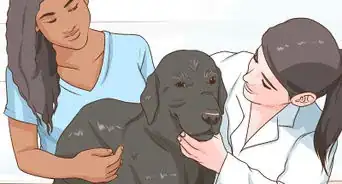
 How to Handle Small Dog Syndrome: Dealing with Napoleon Complex Canines
How to Handle Small Dog Syndrome: Dealing with Napoleon Complex Canines
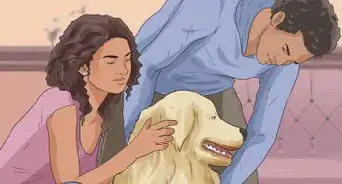





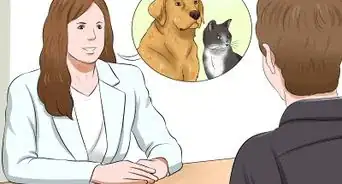
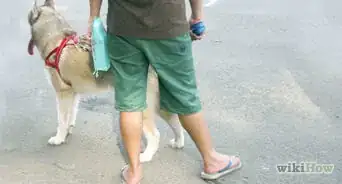


References
- ↑ https://www.ddfl.org/resources/understanding-aggressive-behavior-in-dogs/
- ↑ https://www.aspca.org/about-us/aspca-policy-and-position-statements/position-statement-pit-bulls
- ↑ https://www.legalnewsonline.org/the-top-5-dog-breeds-with-aggressive-behavior/
- ↑ https://www.foundanimals.org/how-to-socialize-a-dog/
- ↑ https://www.akc.org/expert-advice/advice/dog-hate-other-dogs/
- ↑ https://www.animalhumanesociety.org/behavior/socializing-your-dog
- ↑ https://resources.bestfriends.org/article/aggressive-dog-resources-getting-help
- ↑ https://www.akc.org/expert-advice/training/dog-muzzles-when-why-how-to-use/
- ↑ https://www.animalhumanesociety.org/behavior/socializing-your-dog
- ↑ https://resources.bestfriends.org/article/dog-training-dos-and-donts
- ↑ https://www.mdspca.org/wp-content/uploads/2019/09/Aggression-in-Dogs.pdf
- ↑ https://www.aspca.org/pet-care/dog-care/common-dog-behavior-issues/aggression
- ↑ https://www.akc.org/expert-advice/training/changing-your-dogs-behavior-with-desensitization-and-counter-conditioning/
- ↑ https://www.akc.org/expert-advice/training/changing-your-dogs-behavior-with-desensitization-and-counter-conditioning/
- ↑ https://www.akc.org/expert-advice/training/changing-your-dogs-behavior-with-desensitization-and-counter-conditioning/
- ↑ https://vcahospitals.com/know-your-pet/introduction-to-desensitization-and-counterconditioning
- ↑ https://www.akc.org/expert-advice/training/changing-your-dogs-behavior-with-desensitization-and-counter-conditioning/
- ↑ https://www.animalhumanesociety.org/behavior/socializing-your-dog
- ↑ https://www.akc.org/expert-advice/training/fit-dog-training-busy-life/
- ↑ https://www.animalhumanesociety.org/behavior/aggression-dogs
- ↑ https://resources.bestfriends.org/article/aggressive-dog-resources-getting-help
About This Article

